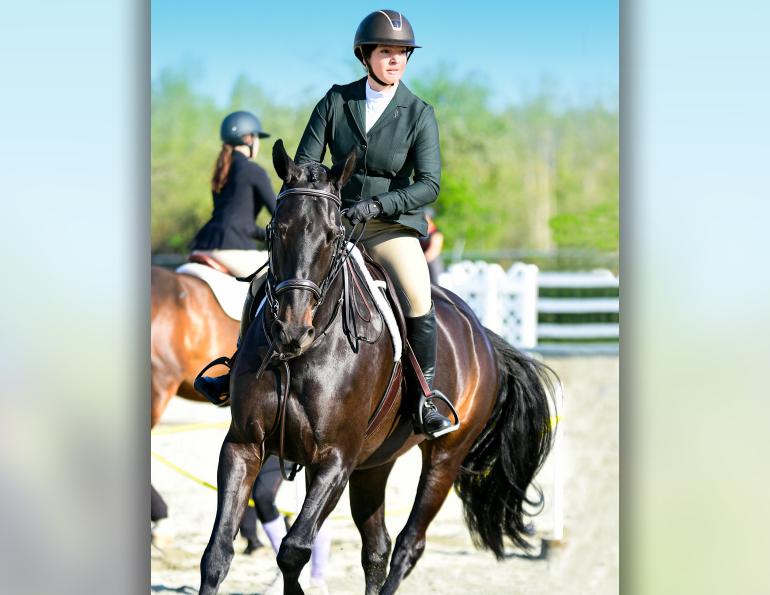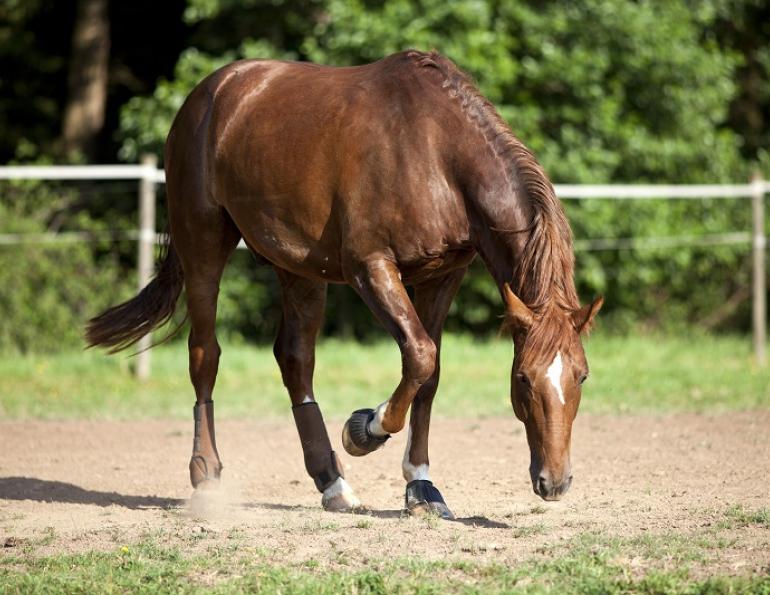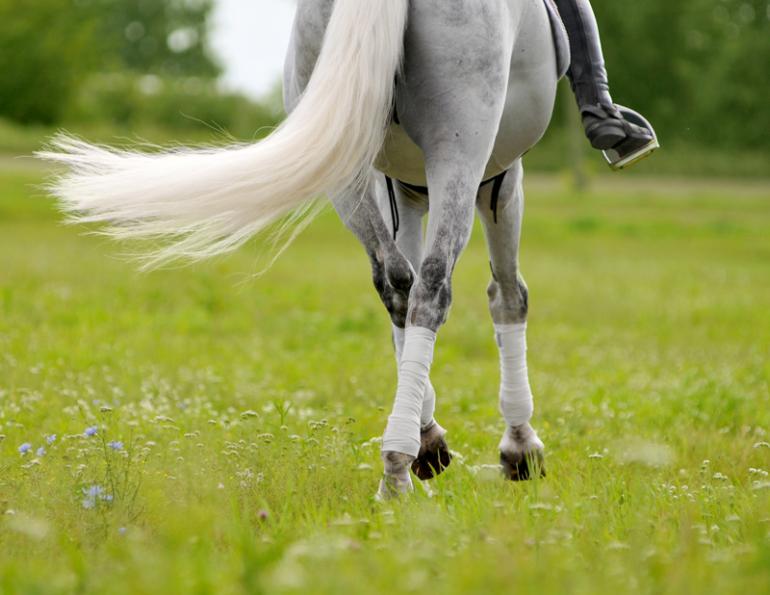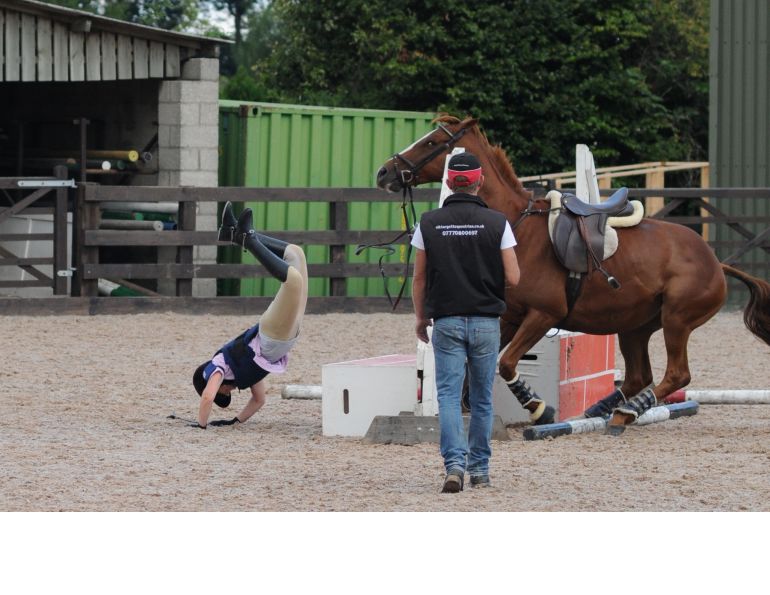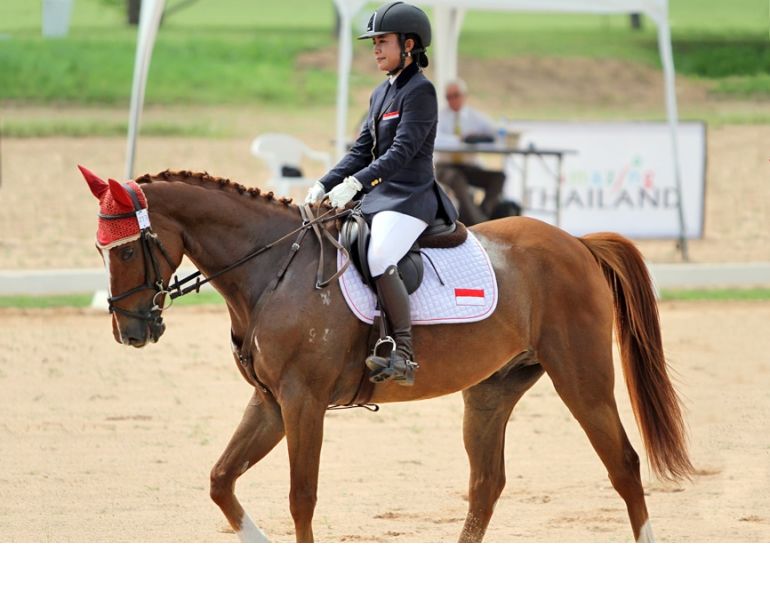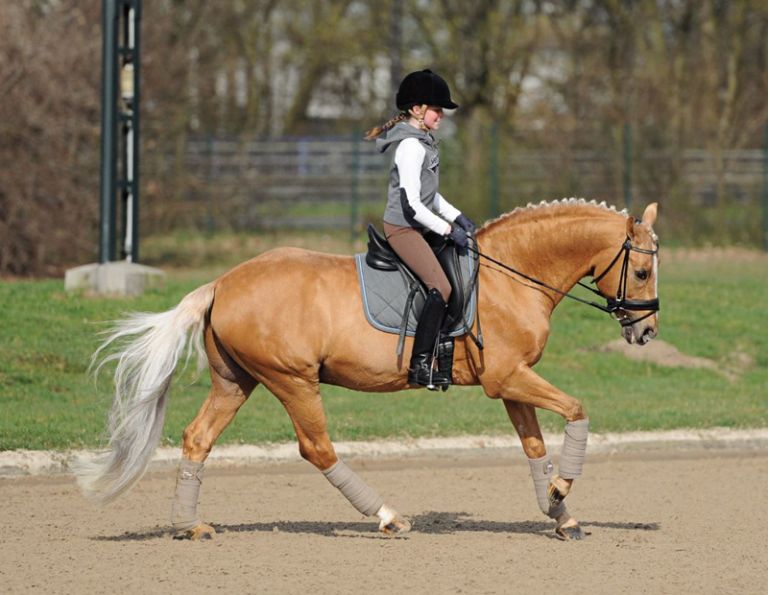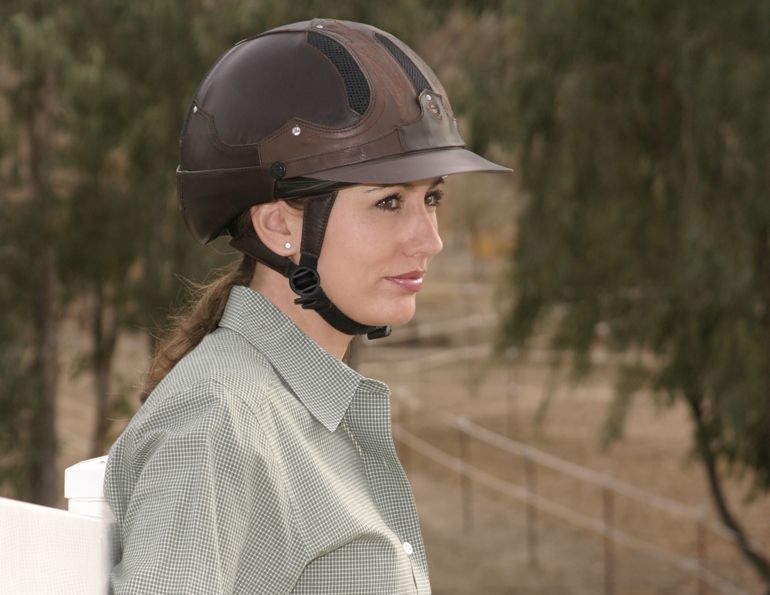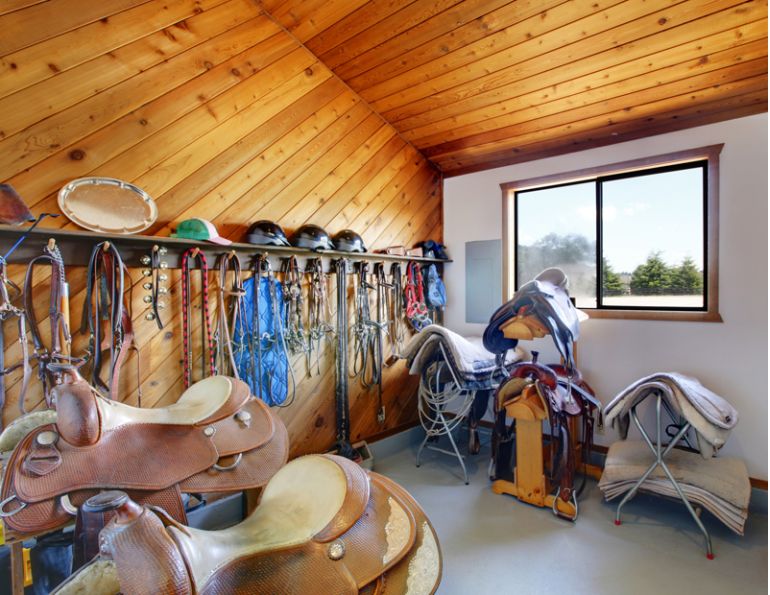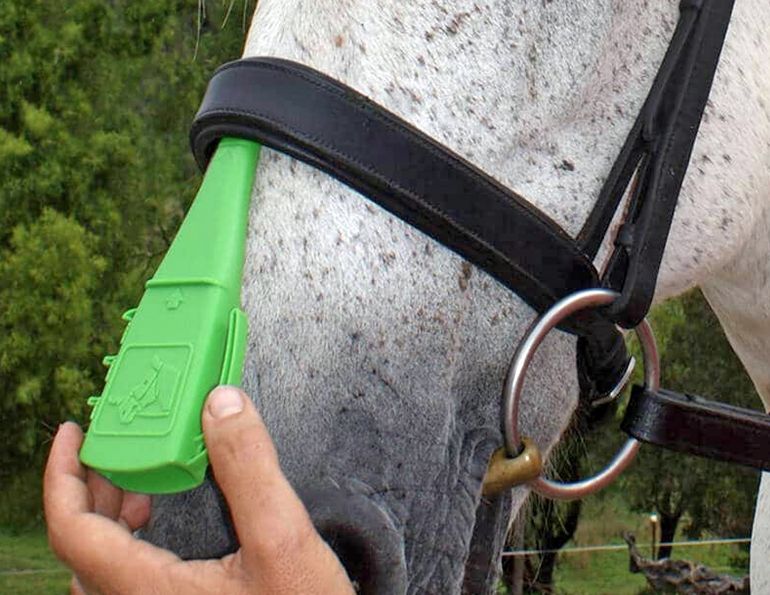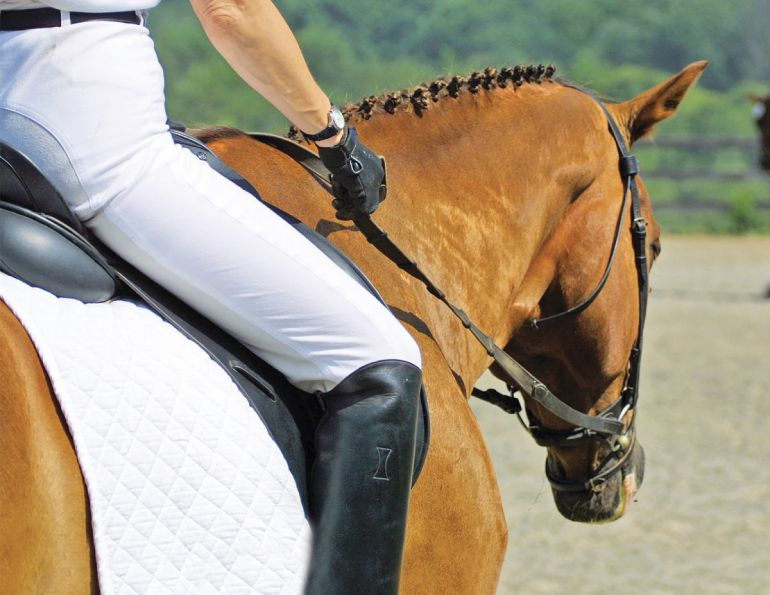Sifting through truth, tradition, and emotion
By Lindsay Grice, Equestrian Canada coach and judge
When we think of training tack, we think of whips, spurs, nosebands, and martingales. It’s a divisive topic in the horse industry. Horse show committees, popular clinicians, coaches, competitive and casual riders all differ in their views. In a sport where truth, tradition, and emotions often collide, I’ve had to sift through the issues to form my own system as a horse trainer, show judge, and riding coach. By trial and error, from training hundreds of horses and watching countless horses and riders, I’ve honed my sense of what works and what tends not to.
But personal experience alone is not a guarantee of truth; I weigh my experience against research findings. The emergence of equitation science has supplied fascinating insight into how horses think and learn.
Do artificial aids themselves cause stress, or is stress caused by the way those aids are used? I’ve heard it said that the best teachers are the curious so I ask lots of questions. As a result my thoughts about artificial aids have been challenged and shaped over the years.
When first meeting a rider in a clinic or for a lesson, I usually ask why they’ve chosen their bit or tack. Responses vary from It’s the tack that came with the horse when I bought him or It’s what everyone’s using, or I just like the look of it!
Sometimes, there’s a well-reasoned reply, formed from thinking through the facts: I understand the mechanics of how the equipment works and on which part of the horse. Based on that, I’ve chosen this equipment to help solve this issue for this horse.
Jim Wofford, revered coach and US Olympic eventer, shared his insights in his Practical Horseman column The Times They Are a-Changin’ on the “mindless application of equipment, regardless of whether it is suitable for this horse at this stage of training” as follows:
“Nosebands are one of my many irritants when coaching… Almost every horse I see is wearing one. Flash nosebands are inherently ill-fitting; a flash is basically an inefficient figure-eight noseband so they are invariably overtightened, causing a pronounced indentation in the flesh of the nasal bone and, occasionally, small sores on the lips. In addition, these nosebands can interfere with the horse's normal swallowing mechanism, producing the very resistance they are intended to cure.
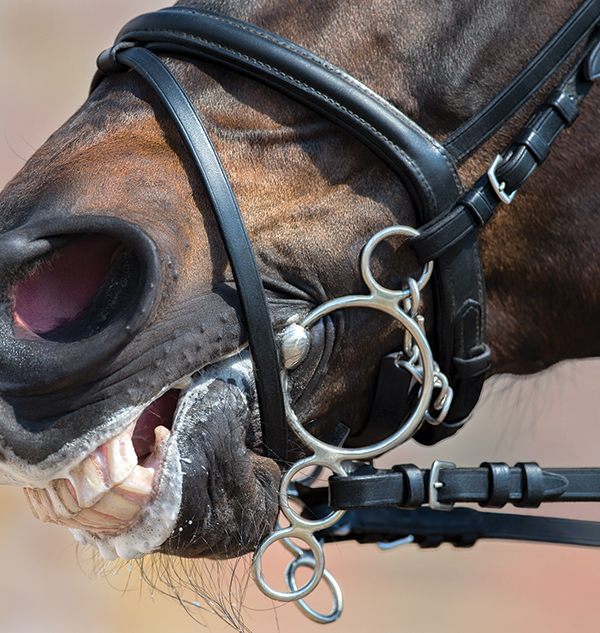
We are routinely preventing normal swallowing, chewing, yawning, and licking in the name of sport. - ISES. Photo: iStock/Abramova Ksenlya
“I can’t decide which irritates me more: overtightened nosebands or the mindless application of equipment, regardless of whether it is suitable for this horse at this stage of training… Yet when I ask riders whether they have tried other nosebands, or even no noseband, they look at me as if I had just stepped down the ramp of the mother ship.”
Related: Would Your Horse's Noseband Pass the Test?
In barn aisles and on social media platforms, equestrians debate, disdain, and defend the use of training aids, as in the following examples:
Pro: Artificial aids “aid” riders in training effectively and safely. They are useful tools to influence and contain the responses of a 1000-pound animal, or motivate one unresponsive to learned signals.
Con: These gadgets are training shortcuts, compensating for a lack of skill. They’re bad for the industry; spectators see them as abusive and this reflects poorly on our sport. They stifle normal equine behaviour and are a source of stress. As one writer for the UK magazine Horse & Rider once asserted, “The whip is an admission of failure.”
I’m convinced the answer lies somewhere in the middle. Let’s lift the lid on the tack box, looking objectively at the evidence concerning training aids — how to choose them, use them, and avoid the ways we might abuse them.
HOW TO CHOOSE THEM
We teach horses in a language of aids, which are cues or signals to bring a response.
An artificial aid is equipment used to back up a rider’s light aid. Examples are spurs, whips, martingales, and draw reins. There are endless variations of these devices used in the quest to lift, lower, or supple the neck, round the back, slow down the legs, or speed them up.
As decision-makers in the horse/human partnership, we owe it to our horses to clearly define our expectations such as, for example, the boundaries of speed, shape, and direction; a six- or twelve-foot canter stride; the amount of lateral bend in the horse’s body; short frame or longer outline.
Correct Release Draw Reins
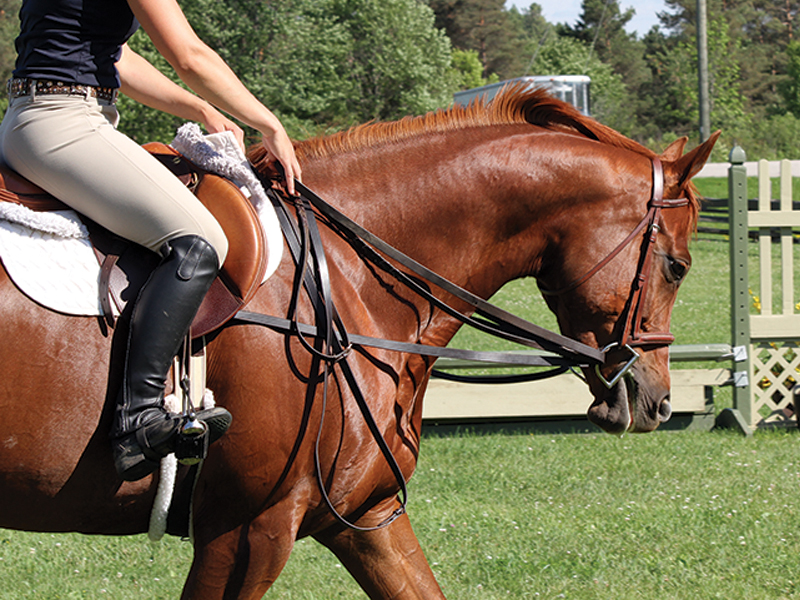
Above: The correct release with draw reins may feel exaggerated. It takes some skill for riders to develop a timely and clear release when using draw reins. Photo: Peter Bruce
Draw Reins Held in Place
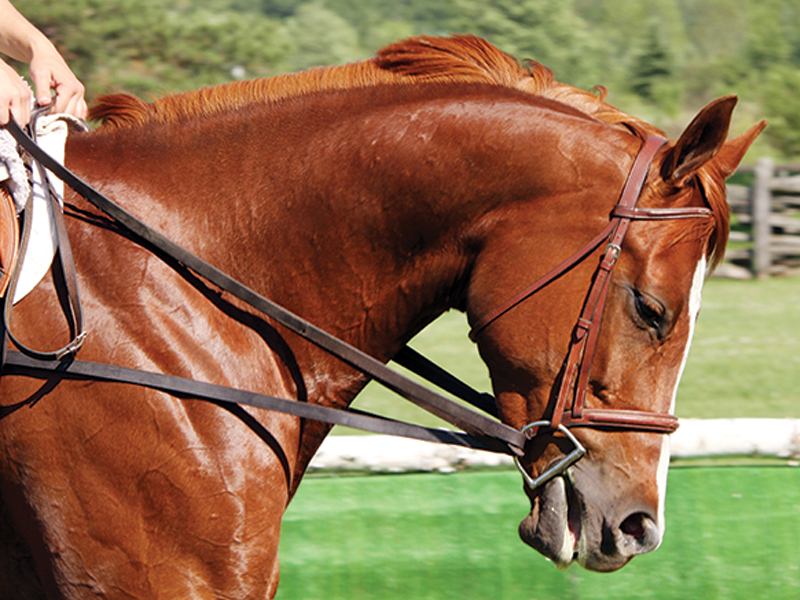
Above: A horse can’t develop self-carriage if his head is held in place. Photo: Peter Bruce
Draw Reins Between Legs
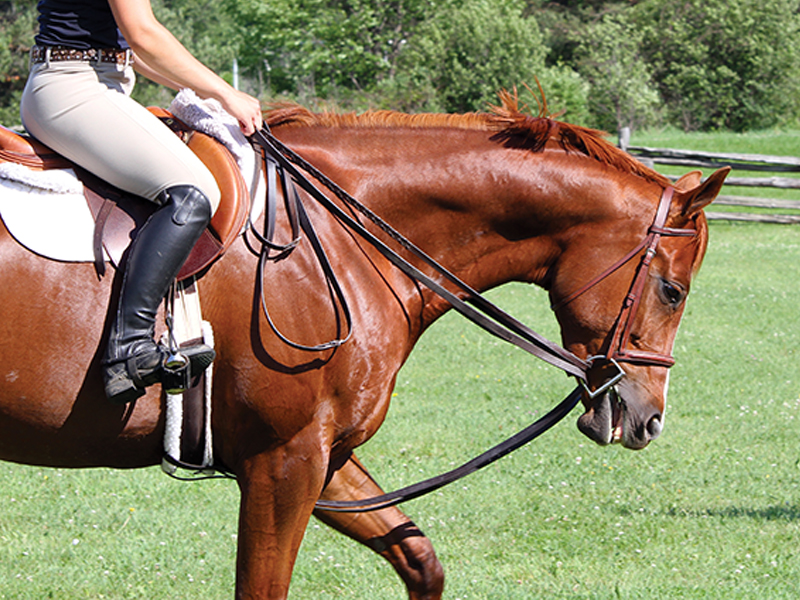
Above: Check your rule books before you attach draw reins between the horse’s front legs. Such an attachment is not permitted by some organizations, even in the warm-up ring. Photo: Peter Bruce
What shape is the “box” you are setting around your horse? —
When my horse stays inside the box without being held in place, that’s self-carriage, similar to cruise control. He’s discovered the box’s boundaries by trial and error, and with any unauthorized changes he’ll meet my aids. For example, if he speeds up, he’ll meet my rein contact. If he cuts a corner, he’ll find my inside leg. If his rhythm falters, he’ll encounter my leg nudging him forward again. In turn, my horse discovers what I DO want by trial and error, finding release within the box. Negative reinforcement is the main way we train horses, taking away (negative) the annoying pressure to reward (reinforce) the behaviour we want.
Our ultimate goal is to use the lightest of pressures. However, if a horse becomes desensitized to those light pressures, a rider may choose an artificial aid as a reminder.
The training aid you choose may depend on:
- Which boundary of the box you wish to emphasize;
- How much pressure it takes to motivate your horse;
- Your current level of skill to use the tack effectively;
- What’s permitted in the schooling areas and show rings of your riding association.
The back and sides of the box — Spurs and crops address the back or sides of the box. Has your horse become dull, content to lean against your leg signal like the butt bar of a horse trailer? Spurs help deliver the appropriate amount of motivation if your light “go forward” or “move over” signal is ignored. As soon as your horse responds, immediately lower your heel and soften your leg to send him the “thank you” note.
The whip should be used directly behind your leg to follow its nudge. Technique is important. Less confusing to your horse than individual wallops are continuous whip-taps, just until he responds. By trial and error, horses figure out that only acceleration turns off the tapping.
Using the whip without affecting the rein in your whip hand takes practice. Choose a whip for schooling that is long enough to reach the horse’s barrel and lightweight enough for you to tap. Length and weight of the whip in competition is determined by your riding association.
Related: How Can I Tell if My Saddle Fits Correctly
The top of the box — With martingales and Western tie-downs, the horse encounters pressure when he elevates his head, lowering it into freedom. Running and standing martingales are the most common types. A tight martingale, allowing no release, defeats the purpose. The horse must be thinking: So where DO you want me to carry my neck?
The front of the box — Draw reins and side reins correspond to the front of the box. Like a pulley, draw reins augment the rein aids in order to influence head carriage and outline. They function differently according to the height at which they’re attached to the saddle. It takes some skill for riders to develop a timely and clear release with draw reins.
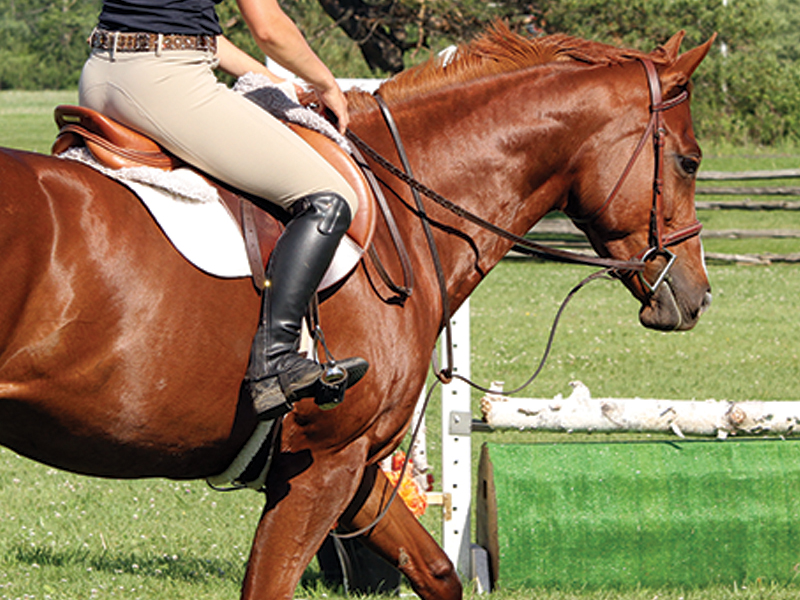
Above: A standing martingale, adjusted too long, may entangle a horse’s legs when jumping or after a stumble. Photo: Peter Bruce
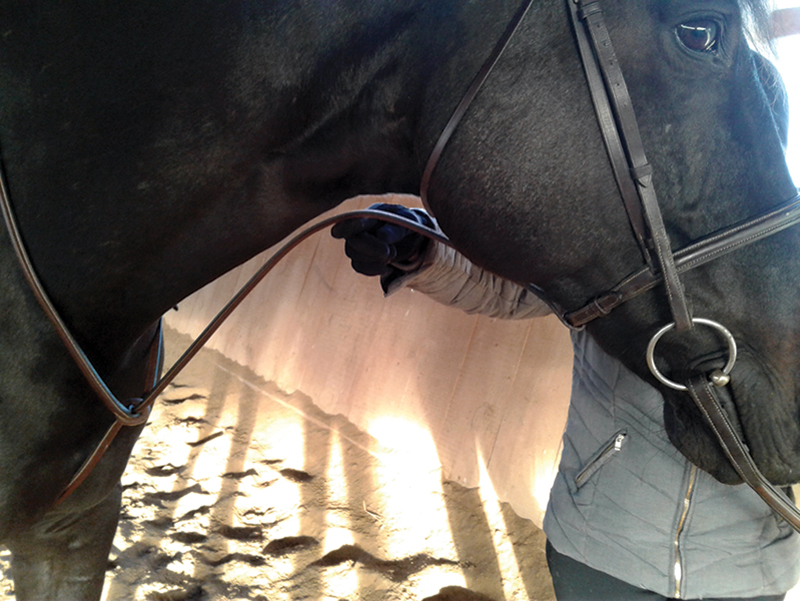
Above: A standing martingale strap, when lifted, should reach almost to the throatlatch of the horse. Photo: Lindsay Grice
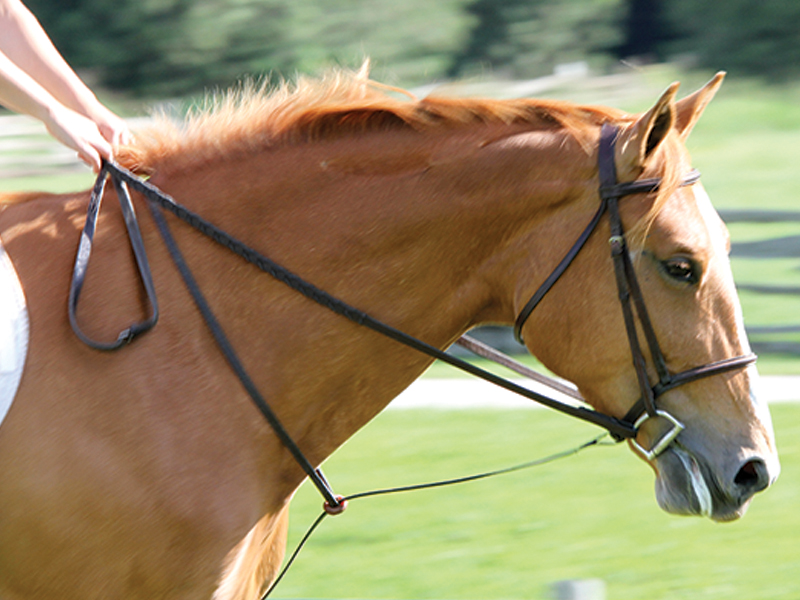
Above: Standing martingales, ubiquitous in the hunter ring, are permitted in only the lower levels in the jumper ring. This martingale is too tight. Photo: Peter Bruce
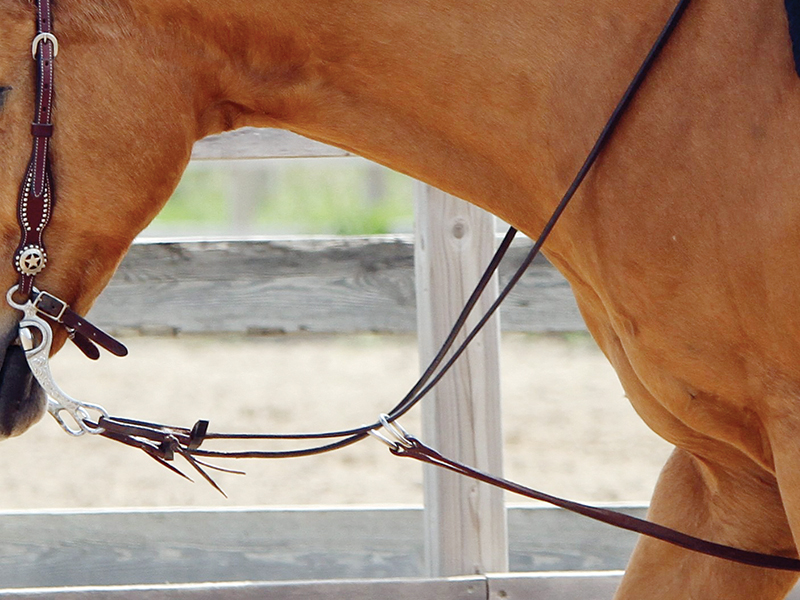
Above: Although this Western martingale is adjusted too tight, it does have the required rein stops. Photo: Lindsay Grice
HOW TO USE THEM
Artificial aids may either amplify or replace a rider’s natural aid.
Amplify — Used after the first cue, training aids motivate a response when the light aid doesn’t. This logical system (light cue, stronger cue, reward) is similar to a car’s lane departure warning, alerting the other drivers of your intention to change lanes. It’s then up to the other drivers to take corrective action. Soon, all it takes is a light signal to inspire self-carriage in the horse — freedom is found within the perimeter.
Replace — An artificial aid may act in place of a natural cue. Lunge or dressage whips, even spurs, can serve as a reaching assist to touch precisely the right spot. Side reins and other lunging devices substitute for the rider’s hands, setting clear boundaries.
A horse can’t find the boundaries of a box when those boundaries keep moving. I teach riders the importance of applying cues at the same place, in the same way, and releasing at the right moment. Although training aids should be reserved for those who have developed independent use of the seat, legs, and hands, occasionally tack “aids” the horse by replacing unsteady signals.
Standing martingales, for example, may balance human error for hands not yet educated enough to provide a consistent box “lid” or when hands are busy, such as when roping. Check the adjustment: With your horse in neutral topline, is the martingale strap too tight or too slack?
An over-check limits the extent a horse can lower his neck —handy for young pony riders!
It’s hard to deny that these tack items are overused and under evaluated. Yet, I also see them appropriately and temporarily used by others.
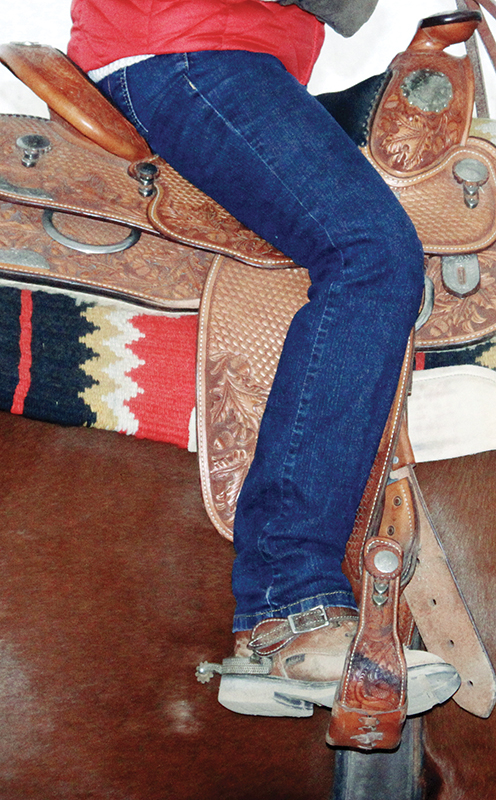
Above: Elevated heels lead to a dull horse. Lower your spur and relax your ankle at the moment your horse accelerates or yields to your leg cue. Photo: Lindsay Grice

Above: Use a whip behind your leg to supplement your leg cue. Photo: Peter Bruce
Related: What Equestrian Equipment is Allowed in the Show Ring?
HOW TO ABUSE THEM
Now let’s consider how riders might abuse artificial aids.
After years of watching horses and riders and exploring the evidence, I’m convinced it’s not so much the equipment that’s stressing out the horses as much as it is the careless operators of the equipment.
We are careless operators when…
We have poor timing — A common misuse of artificial aids is missing the moment or failing to release the pressure when the horse responds. Conversely, by relaxing the pressure when a horse hasn’t responded, a rider accidently rewards the wrong behaviour.
We startle the horse — Megaphones are handy to amplify and clarify instructions, yet they can startle and intimidate. Surprise the horse with a spur jab before “asking” with the calf and you may be riding out a buck. The hasty tightening of a martingale may panic a horse and cause him to rear. To a horse that hasn’t mastered the basics, stronger bits and more restrictive equipment only amplify signals he doesn’t fully understand. It’s like using a megaphone to communicate a foreign language. Louder isn’t clearer — it’s just scarier. Tack such as martingales, side reins, and draw reins should be introduced gradually. Horses are claustrophobic and prone to panic when feeling trapped. Start with the loosest setting and adjust incrementally.
We trap the horse — When a horse’s correct response isn’t rewarded with freedom, he becomes desensitized and stops trying to find the right answer. Learned helplessness is that apathetic state in which the horse has learned, through trial and error, that there’s just no option to escape the equipment’s pressure. For example, take the controversial issue of racing whip use. Associations vary in pronouncing how often jockeys may strike with the whip in a race, how many times they may strike in a row, and the manner in which they may strike — underhand or overhand. Yet the horse may ask: What behaviour will turn off the sting?
Studies have found while most horses are whipped in a race at some point, it seems that frequent whip use doesn’t lead to winning. While some racing associations mandate the use of cushioned, absorbing whips, we must ask: Is the solution to alter the tool itself, or the method? Do the rules make sense to the horse if not related to his acceleration response?
“In racing, jockeys may use the whip when the horse cannot go any faster; they sometimes stop the whip when the horse has not gone any faster or continue to use the whip when the horse has already gone faster. Small wonder that whips can be ineffective for some racehorses.” — Dr Andrew Mclean.
Draw reins can be abused by trapping a horse in place, achieving a headset by simply holding it there. Used correctly, a rider’s elastic arm provides release the moment their horse finds the “sweet spot.” I ask the riders I teach: “Does your horse understand what you DO want?” Learning comes when the training wheels come off — determine not to babysit your horse with nagging aids.
A martingale, adjusted too snuggly, can trap the horse, interfering with the appealing bascule over the jump. That in itself should be a motivating factor for competitors!
We use tack in the wrong way — We can abuse training tack by using it in ways it’s not designed for. When judging, I’ve seen upside down spurs, curb chains fastened to the wrong ring, and nosebands tightened beyond the intention of their design. While some of these are accidental modifications, others are a premeditated shortcut to gain a competitive advantage. Thus, competition committees annually revise the rules, staying one step behind the shortcuts! (See Don’t Get Caught With Your Splint Boots On! for a sample of current tack rules across several disciplines.)
Are we using tack in the wrong way if only for aesthetics? After all, no hunter is fully dressed without a standing martingale. No horse in any English discipline is fully dressed without a noseband. Logically, I believe if there’s a way to adjust the equipment so the horse finds freedom when he’s within the intended boundaries, there’s no harm in decorative tack.
Related: How to Find Riding Boots that Fit
Related: How to Find the Perfect Horse Riding Gear
Main Photo: Soul Touch Photography



